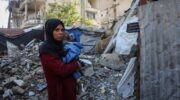Summary
- UN agency says 4,700 new amputees during conflict
- Prosthetics and other aid hard to get into blockaded Gaza
- Doctors warn of further problems from lack of adequate care
By Nidal Al-Mughrabi and Dawoud Abu Alkas, reposted from Reuters, April 10, 2025
CAIRO/GAZA, April 10 – Farah Abu Qainas hoped to become a teacher but an Israeli air strike last year injured her so badly she lost her left leg, throwing all her future plans into doubt and adding the 21-year-old to a list of thousands of new amputees in devastated Gaza.
Still living in temporary shelter, Abu Qainas attends physiotherapy sessions at a prosthetics centre in the territory where she waits in a wheelchair for an artificial limb that could allow her some freedom again.
“That day I lost more than just my leg. My dreams vanished,” she said. “I longed to attend university and teach children. But this injury has stolen that future.”
The war began on October 7, 2023 when Hamas carried out a cross-border attack on Israeli communities, killing around 1,200 people and seizing 251 hostages according to Israeli tallies.
Israel’s military campaign has since killed more than 50,000 Palestinians in Gaza, local health authorities say, and left most of the tiny, crowded coastal territory in ruins and nearly all its people homeless.
Many thousands more have suffered injuries that will change their lives for decades to come. But amid a conflict that has left the medical system barely able to function, estimates for how many Palestinians have lost limbs vary.
“Across Gaza, it is estimated that 4,500 new amputees require prosthetics, in addition to the 2,000 existing cases requiring maintenance and follow-up care,” the U.N. humanitarian agency OCHA reported last month.
Ahmed Mousa, who runs the physical rehabilitation program in Gaza for the International Committee of the Red Cross, said at least 3,000 people had been registered in their program, of whom 1,800 have amputations.
Many thousands more Palestinians have suffered spinal injuries or lost their sight or hearing, according to OCHA and the ICRC.
The large number of injuries has slowed and complicated efforts to provide treatment. Getting artificial limbs into the Gaza Strip has been a challenge, ICRC officials said.
“Accessing proper prosthetics or mobility aids is increasingly challenging in Gaza right now and unfortunately there is no clear timeline for many,” said Mousa.
Israel suspended all humanitarian aid into Gaza after the collapse of a two-month-old ceasefire last month.
Gaza in short supply for artificial limbs as war drags on
Abu Qainas, who attends Moussa’s therapy program, said she does not know when she might get an artificial leg or treatment abroad. “They told me to wait but I don’t know if it’s going to happen anytime soon,” she said.
Israel’s military has said its bombardment of Gaza is necessary to crush Hamas, which it accuses of hiding among the general Palestinian population. Hamas denies this. Israel says it tries to reduce harm to civilians.
Child Amputees
Children have not escaped the carnage.
An April study by the Palestinian Bureau of Statistics said at least 7,000 children have been injured since October 2023, with hundreds losing limbs, sight or hearing.
Seven-year-old Shaza Hamdan had wanted to learn to ride a bike, she said.
“My father asked (me) to join him for a walk, before shells began falling on us like rain. One hit my leg and cut it off, and another hit my father’s arm,” she said.
Shaza underwent surgery twice and the doctor had to perform further amputation on the injured leg because of inflammation.
“I became dependent on my mother. She does everything for me. My life is worse than before. Before I was injured, I could play,” she said.
Her father, Karim Hamdan, said Shaza’s mental health worsened as she waited to go abroad for treatment.
“There are no artificial limbs in Gaza, and the only solution is to go for treatment outside Gaza. The girl has grown impatient, asking many questions, and she cries every day. She wants to feel a bit normal,” he said.
Ismail Mehr, an anesthesiologist from New York state who has led several medical missions to Gaza during the current and previous wars, said shortages of adequate care meant more limbs could be lost and already amputated limbs cut back further.
“Over 99% of amputations were performed in substandard conditions, through no fault of the doctors, lacking proper sterilization, equipment, and sometimes even performed by physicians not normally specialized in such procedures,” he said.
Reporting by Nidal al-Mughrabi; editing by Angus McDowall and Mark Heinrich
Nidal al-Mughrabi is a senior correspondent with nearly 25 years’ experience covering the Palestinian-Israeli conflict including several wars and the signing of the first historic peace accord between the two sides.
Dawoud AboAlkas is a photographer in the occupied Gaza Strip.
RELATED ARTICLES:
- Israel accused of releasing Palestinian detainee with amputated legs to evade treatment
- ’42 Knees in One Day’: Israeli Snipers Open Up About Shooting Gaza Protesters
- Hundreds of Gaza protesters shot by Israeli forces risk limb amputation
- Gideon Levy: A Young Gazan’s Dream, Amputated
- Israeli Troops First Shot a Gaza Journalist’s Left Leg, Then His Right. And They Didn’t Stop There
- Palestinians launch national football team for amputees
- The Olympics: Do Only Israeli Victims Matter?




